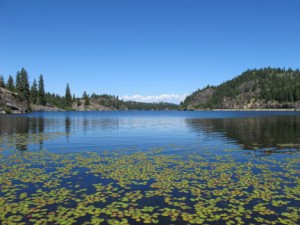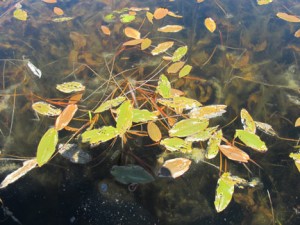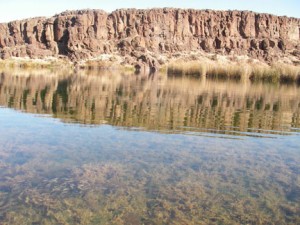by Jenifer Parsons, Washington Department of Ecology
Aquatic plants are an often misunderstood and under-valued part of lakes and rivers. Though many people would rather not have them in their favorite swimming spot or fishing hole, native aquatic plants provide varied environmental benefits to many lakes.
Food – Aquatic plants are a food source for many animals.
- Ducks and geese eat the seeds, leafy parts and tubers of plants such as pondweed (Potamogeton spp., Stuckenia spp), watershield (Brasenia schreberi), arrowhead (Sagittaria latifolia), water pepper (Polygonum spp.) and duckweed (Lemna spp.).
- Songbirds use fluff from cattails (Typha spp.) as nest material and eat the seeds of many emergent plants.
- Otter, beaver, muskrats, turtles, moose and even bear graze on a variety of aquatic plants.
- Several kinds of invertebrates, especially aquatic insects, eat aquatic plants.
- Historically, humans have also used aquatic plants as a food source. Cattails have edible shoots and roots, and the pollen has been used in biscuits. Arrowheads form large edible tubers at the root ends. These “duck potatoes” were eaten by Native Americans. Watercress (Rorippa nasturtium-aquaticum) has many historic medicinal uses, and its spicy vegetation is still used in salads and garnishes. Water lily (Nymphaea sp.) roots are a common source of food in many parts of the world, and have historically been used as medicine. Even the submerged plant coontail (Ceratophyllum demersum) has been used for medicinal purposes.
Habitat – Aquatic plants provide important habitat for small animals like aquatic insects, snails and freshwater shrimp, which in turn supply food for fish and waterfowl. Studies have shown that vegetated areas support many times the number of these tiny creatures that non-vegetated areas do.
Cover – Young fish and amphibians use aquatic plants for cover from predatory fish and birds. This, coupled with the abundant food supply they offer, makes aquatic plants important nurseries for young fish, frogs and salamanders, including our native salmon.
Housing supplies – Sturdy emergent plants provide many birds and mammals with material for nests and dens. Humans construct baskets, mats, boats and even dwellings from cattail, rush and bulrush stems.
Erosion control – Submersed and emergent plants protect shorelines from erosive wave action or currents. They also help keep sediment on the lake bottom, which increases water clarity.
Nutrient cycling – Aquatic plants are a vital part of the complex system of chemical cycling in a lake, and can influence oxygen supply in the water. Aquatic plants can also soak up pollutants from contaminated water.
Resist invasion – A diverse healthy native plant community is better able to repel invasion by opportunistic exotic weeds.
So what’s the problem?
If aquatic plants are so wonderful, why are they sometimes perceived as a problem? Most of the time, problems arise when dense plant growth impedes recreational activities like boating and swimming. When growth becomes very thick, the density can also harm some fish by contributing to low dissolved oxygen levels at night, or by hampering the search for food or avoidance of predators.
This very dense native plant growth is usually caused by an overabundance of nutrients, often from sources like failing septic systems, fertilizer run-off and agricultural waste. These increased nutrients accelerate the natural process of lake aging (eutrophication), increasing plant and algal growth. Once nutrients are in a lake, they can persist for decades before being flushed out, fueling plant and algae growth even after nutrient sources outside the lake have been addressed.
Another problem can arise if an invasive species is introduced to the lake. This often happens when recreational users unknowingly carry plants from one waterbody to another, or when someone discards aquarium plants into a lake. Exotic species like Eurasian watermilfoil (Myriophyllum spicatum) and Brazilian elodea (Egeria densa) are aggressive and can crowd out more desirable native vegetation.
Learn your plants to keep lakes healthy
What can individuals concerned about lakes do? Preventing or eliminating pollution and curbing sources of excess nutrients are vital steps for maintaining lake health and recovering degraded lakes. In addition, you can better monitor lake health year to year if you get familiar with aquatic plant species and typical seasonal changes in vegetation. Educated observers can often detect invasive non-native plants at an early stage, when control or elimination is easier and cheaper. However, proper identification of aquatic plants, particularly non-native species, can be tricky. Check out the aquatic plant field guide on Ecology’s website for help: http://www.ecy.wa.gov/programs/wq/plants/plantalgaeid.html.
If you are still unsure about what plant you have, send a photo to me (jenp461@ecy.wa.gov) or your county noxious weed control experts. We will help you identify the plants and the steps that should be taken, if any. Let’s work together to keep our lakes healthy!












